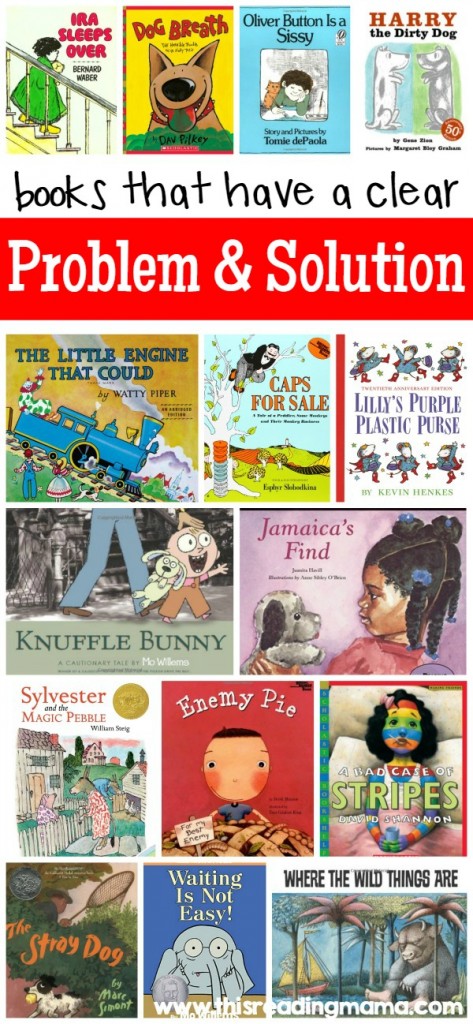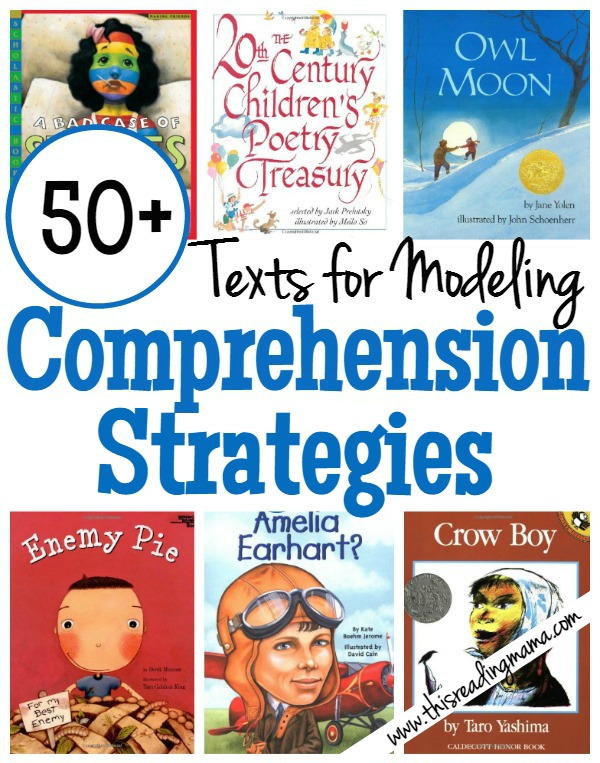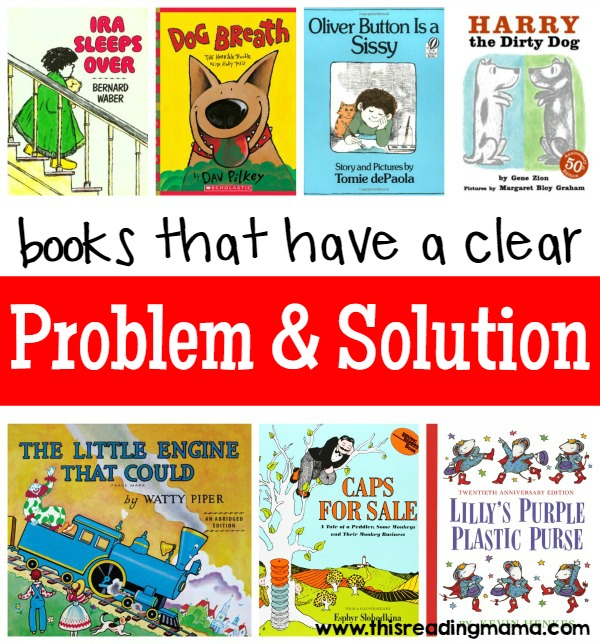When teaching kids how to comprehend and/or write fiction text, often times it’s good to start with books and stories that have a clear problem and solution text structure.
This means that the story line introduces characters and a problem at the beginning –> the character(s) try to solve the problem in the middle, which rises to a climax –> and at the end, the problem is solved, with the “good” guy winning.
The determining importance post, from our Reading Comprehension Series, has a great visual to SHOW this progression in fiction text. We also have lots of free, graphic organizers for fiction text structure here.

*This post contains affiliate links.
Books with a Clear Problem and Solution Structure
Today, I’m sharing 16 of our favorite books that feature a clear problem and solution structure to help kids see how fiction texts are often composed. By the way, these texts aren’t just great for comprehension, but can also be used to help kids WRITE their own fiction stories as well, an extra bonus!
Ira Sleeps Over by Bernard Waber is about boy named Ira, who becomes anxious quite about what his friend, Reggie, will think of him if he brings his teddy bear over to spend the night. This is a GREAT book for teaching text-to-self connections as well as the problem and solution text structure.
Dog Breath by Dav Pilkey is a pun-filled book about a family pet, Hally Tosis, who has incredibly bad breath. The Tosis family tries to help Hally get rid of the bad breath to no avail. But dog breath may actually be a good thing, especially when two thieves visit the Tosis family!
Oliver Button is a Sissy by Tomie dePaola is about a little boy named Oliver who is clearly different than all the other boys at school. He’d rather paint, tap dance, and read instead of playing sports like all the other boys, which earns him the name, “Sissy.” But once he shows his dancing skills at the school talent show, he receives a new name – “Star.”
Harry the Dirty Dog by Gene Zion features a cute little family puppy who despises his baths. So much so, that he hides his bath brush and runs away. As he is away, he gets very dirty, from a white dog with black spots to a black dog with white spots. As hunger strikes, he heads home only to find that the family doesn’t recognize him.
The Little Engine by Watty Piper is a classic book that features a clear problem and solution structure as the little engine helps the broken down engine climb over the mountain to deliver toys to all the boys and girls on the other side of the mountain.
Caps for Sale by is such a fun and interactive book about a peddler who gets his caps stolen by a bunch of monkeys. He tries, in anger, to get his caps back, only to be mocked by the monkeys. What will he do to get all those caps back? Such a simple solution that kids may be able to predict as they read along.
Any of Kevin Henkes’ books are great for teaching the problem and solution text structure with fiction. One of my daughter’s favorites is Lilly’s Purple Plastic Purse. Lily loves her purple plastic purse so much she brings it to school to share, but Mr. Slinger, her teacher, takes it from her. To get revenge, she draws a mean picture of her teacher only to have him see it. She begins to feel great remorse for her actions and wants to make amends. Will Mrs. Slinger forgive her?
Mo Willems is one of my kids’ favorite authors. Knuffle Bunny was probably the first book they were introduced to by him. Trixie and Daddy take a trip to the laudromat. On the way home, Trixie realizes Knuffle Bunny has been left behind. Follow the journey of Trixie and Daddy as they try to get Knuffle Bunny back. There are more Knuffle Bunny adventures including Knuffle Bunny Too, but I warn you to keep a tissue box handy when you read Knuffle Bunny Free.
Jamaica’s Find by Juanita Havill features a little girl, Jamaica, who finds a stuffed dog and hat at the park. She takes the hat to the lost and found, but decides to keep the stuffed dog for herself. She finds herself wondering if she’s done the right thing by keeping the dog. She finally decides to take it back to the lost and found and finds a friend along the way. This book is a great one to show that characters don’t always face external problems; sometimes characters have internal struggles and problems.
Sylvester and the Magic Pebble by William Steig is about a donkey named Sylvester who finds a magic pebble. Just then, a lion comes to attack him and he wishes to be a rock. Sylvester is changed into a rock, but he can no longer hold the magic pebble to wish himself back into his usual form. His family looks high and low for him and is eventually returned to his family. William Steig has such a way with words and his books can fit into multiple comprehension strategies, such as asking questions.
Enemy Pie by Derek Muson is such a fantastic book for many comprehension strategies. It’s been one of my favorites for a long time and I LOVE reading it to kids who have never heard the story. When a bully (Jeremy Ross) moves into the neighborhood, the young boy’s summer is ruined. That is until the young boy’s father says he can help get rid of the bully (enemy) by making him some enemy pie. The boy wonders: What is “enemy pie” and how does it work? Will it get rid of enemies? What does it taste like? Will “enemy pie” solve all his problems?
Camilla worries about what others think of her so much that on the first day of school, she wakes up with a bad case of the stripes…and much more! Her body adds on the ailments of every fear she has until a kind, old lady helps her to learn that it’s okay to just be herself. A Bad Case of the Stripes by David Shannon has an explicit external conflict, but kids have to read “in between the lines” to get the internal problem Camilla faces and eventually conquers.
The Stray Dog by Marc Simont is one of the books we used an example for our determining importance post with fiction. A family goes for a nice picnic away from the city only to meet a cute, stray dog. They leave the park without the dog, but think about him all week. The next weekend, the family returns to the park, hoping that the stray dog will show up again. He does, but now they have another obstacle to overcome. Such a cute book and one that requires kids to pay attention to the story that the pictures also tell.
If I had a dollar for every Elephant & Piggie book we’ve read {and re-read} this school year, I’d be rich! 🙂 All of his books contain a clear problem and solution format, but in such a fun and playful way that kids WANT to read these. While the words are written for the 1st grade level, older kids will enjoy them, too. Waiting is Not Easy! is one of Mo Willems’ newest Elephant & Piggie books and was also featured in our determining importance post with fiction from our Reading Comprehension Series.
Where the Wild Things Are by Maurice Sendak is another classic book that features a clear problem and solution structure. Max is banished to his room without supper because of his behavior and falls asleep only to “wake up” in a world of wild things. Max begins to long for home again and wakes up to find that his mother has left his supper in his room to eat. I love how Sendak asks kids to read between the lines a bit to figure out how his supper got there and why. So adorable and such a classic!
More Book Lists You May Enjoy:
- 50+ Books for Modeling Comprehension Strategies
- Books to Help you Teach Comprehension
- Letter of the Week Book Lists & Letter Packs
~Becky

















This was helpful. Thanks, I have most of these books.
Is this list available somewhere in document form?
I don’t believe so, but that’s a GREAT idea!
Loved the tips and advice in your article. You explained it well and I guess I am going to apply these in my future writing project. You have to write the book that wants to be written. And if the book will be too difficult for grown-ups, then you write it for children.
Come and visit my blog on Tips on How to Write a Story That’s Perfect for Children
Hope this will help.
Thanks
Attilio
This is useful information that helps me in my future writing. Reading is to the mind what exercise is to the body. It is also to train your mind to imagination to think big. Keep it up!